

Sparring partners
Being a columnist ain’t easy. It wouldn’t even be easy if this was my only gig and there wasn’t some weekly content monster called National DRAGSTER. Don’t get me wrong; this column is still one of the most fun things I get to do each week, and bringing to light untold tales and trivia from our sport’s incredible lore is a huge charge.
The notes I get each week from fans and ex-racers thanking me for helping them remember those halcyon days are a weekly reminder of why I keep digging and keep writing, but, to be honest, it’s not always complimentary.
Sometimes when we get on one of those multiweek threads (ramp trucks, wedge dragsters, etc.), I get hate mail demanding a change of scenery. I get piqued pen pals who just don’t understand why I don’t cover their favorite topic. I get people upset when I have to occasionally skip a column or am late posting.
I have one guy – and I love him for this – who’s my grammar watchdog. (His pet peeve is when I use “of late” -- which, accurately, should be “lately” or “recently,” but I like to write conversationally, and, besides, of late, I’ve refrained from using it.) I have a wonderful copy editor (take a bow, Lorraine Vestal …) who understands what I’m trying to do and leaves that be – or maybe she just gets tired after correcting the other mistakes she finds in my sometimes hurried and excited prose.
I always try to learn from what’s being said and asked for – after all, I’m writing for a public, and I want to make them happy – and there’s nothing wrong with good-intentioned debating.
My most recent fencing foil is longtime reader and veteran SoCal race fan and photographer Robert Nielsen. You might remember him as the guy who shared great early doorslammer photos from Lions or that we crossed swords over who was driving the Beach City Corvette when it ran off the end of OCIR in flames.
(I finally convinced him that it was Ronnie Goodsell and not Gary Gabelich, though fellow reader Chris Clark certainly can understand Nielsen’s point. “Regarding the Beach City Corvette burndowns, both of you are right,” he said. “Don't forget, there were two Corvettes: the first, driven by Gabelich, had the offset cockpit. The other difference was the first one did not have the polished Halibrand wheels. Gabelich was the driver when it burned to the ground at Irwindale I think in the final round against Tom Sturm. The second one, driven mainly by Pat Foster, was the one that ended up on I-5 with Goodsell at the wheel.”)
Anyway, after finally conceding the Goodsell point, Nielsen wrote,” I hereby solemnly vow to not ever question you again – at least until the next time.”
The next time came quickly, under a subject line that read: "Well It Did Not Last Too Long."
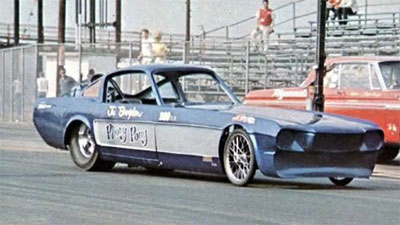 |
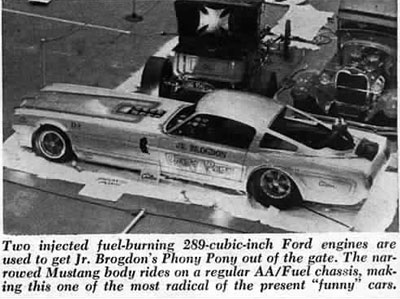 |
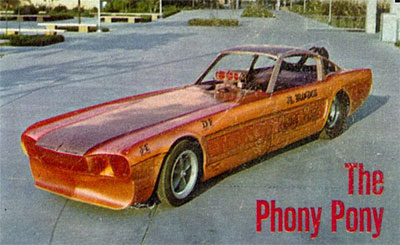 |
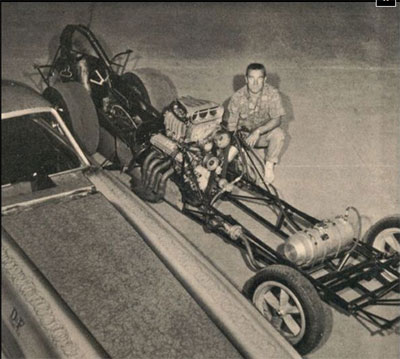 |
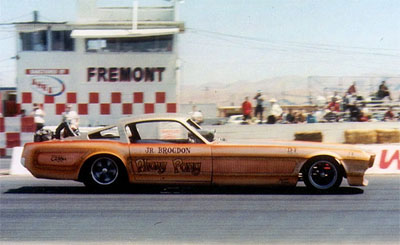 |
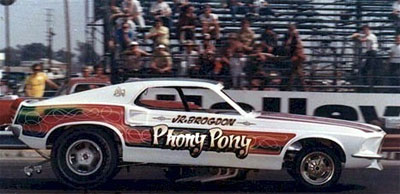 |
Although he quickly corrected himself two days later (I was right again. ... LOL), I loved that he cared enough to write, and the information he shared was great stuff. Nielsen took issue with my including Junior Brogdon’s Phony Pony Mustang in the all-too-short multiengine Funny Car list, and his source was good: himself.
“As a Ford racer who grew up in the San Fernando Valley, I came to know Junior quite well and bought a fair number of small-block Ford parts from him,” he wrote. “When Junior built this car, he wanted to do something that was unique. The result was a Mustang that was very narrow, very long, and relatively lightweight. The driver’s seat was over the rear axle, as you can also see in this picture. A lot of people used to comment that this was just a Jr. Fuel Dragster with a Mustang body, which for some reason would make Junior bristle a little bit.
“The Phony Pony Funny Car that was pictured did indeed have an injected small-block Ford – but only one engine. It did not have twin engines! If you look closely at the hood near the windshield, you can see the opening for the injectors – one set, not two! When the performance Junior was expecting did not materialize, he later put a blower on the engine. After campaigning this car for a couple of seasons, he moved to a more conventional 1969 Mustang Funny Car with the 392 Chrysler Hemi.”
Looking through the cool collection of photos I have found on the car, you can see it in a couple of different configurations, and you can see that it was indeed at one point powered by a single engine. You also can see that it once had spoked dragster wheels, which is why a lot of people said it was just a bodied dragster.
Two days later, Nielsen good-naturedly recanted his assertion.
“It was indeed a twin-engine small-block Ford-powered car when it was initially built,” he said. “I know his thinking was that the long narrow car would be unique and set it off from most of the other Funny Cars of the period. This would make the car more attractive to race promoters and ensure him of getting more appearance money and not have to rely on winnings to finance his car.
“The twin-engine configuration lasted only a very short time, though, as he had a tremendous problems coupling the two engines. Added to this was the cost of having to maintain two engines versus the cost of one engine. Since Junior had a very limited budget, the cost issue is probably the significant factor that drove him to the single-engine configuration that I remember seeing.
“Let me add one additional fact here. While this car was billed as a 289 small-block Ford, it was a little bigger than that. Junior used a 3/8 stroker crank in the single-engine car that yielded an engine displacement of 348 cubic inches. Because he was matched against cars with much bigger engines, he generally pushed this engine configuration to the limit. And that resulted in moderately low reliability and a lot of broken parts. Junior finally threw in the towel with this car and built a more conventional 1969 Mustang with a 392 Hemi, but this too was not very successful, probably as a result of his limited budget once again.
“The bottom line once again – and I hate to admit it – is that you were right and I was wrong. Well, maybe not entirely wrong since the only configuration I ever saw was the single-engine car.”
At right is a photo of the later and more conventional Phony Pony flopper that, unlike the stretched Mustang, was legal for national event competition and ran in the sevens before Brogdon retired it at the end of 1970. He later raced a Pinto Pro Stocker in the mid-'70s with little success; according to Nielsen, this car had a 351 small-block Ford for power and was called Pee Wee because it was only about one-third the length of his first Phony Pony Funny Car. Brogdon later moved to Oklahoma and quit racing.
The back and forth that I have with my readers – the good and the bad – is what makes this column come alive and makes me dig deeper and ask more questions. I won’t ever say I’m right all of the time – I’m going to make Nielsen say it when I see him in Pomona – but even when I’m wrong, there’s always something to be learned from it, which makes this a pretty cool place to hang around.



















































